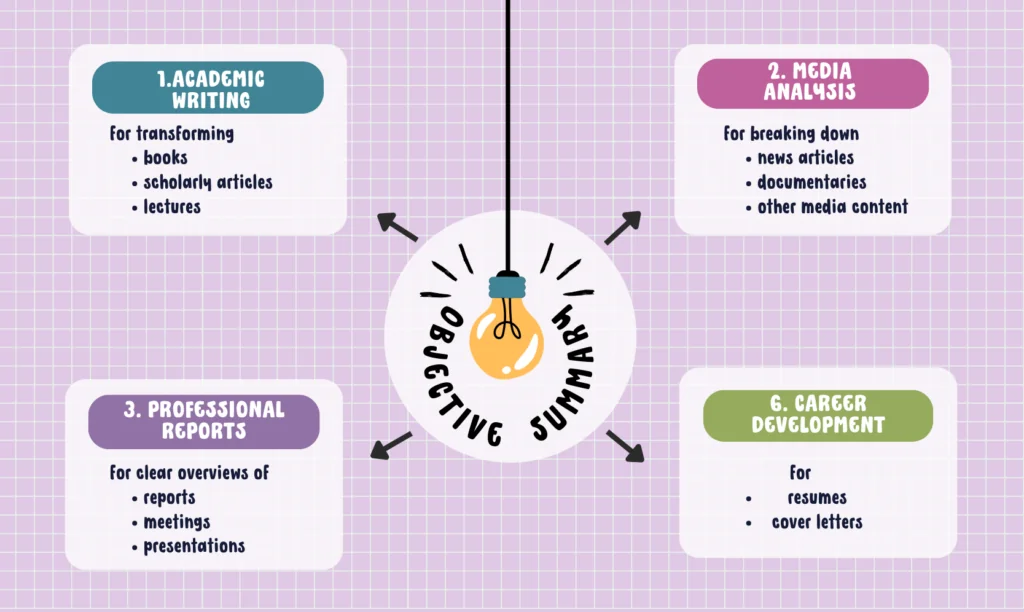A summary is a concise and coherent version of a longer piece of writing, such as an article, lecture, or book. It filters the main ideas, arguments, and key points into a shorter form, allowing readers to grasp the essence of the original work quickly. In academic writing, summaries help students and researchers synthesize information, understand complex concepts, and engage with the content critically.

✅ AI Essay Writer ✅ AI Detector ✅ Plagchecker ✅ Paraphraser
✅ Summarizer ✅ Citation Generator
Objective Summary: What is it and What is it Made of?
An objective summary is a concise and impartial distillation of the essential content from an original piece of writing, such as an article, report, or book. It aims to present the main ideas and key points clearly and accurately, without any personal bias or interpretation. The primary purpose of an objective summary is to provide readers with a clear understanding of the original content without the need for them to read the entire piece.
The characteristics of an objective summary are necessary for its effectiveness:
- Neutrality: The summary maintains a neutral tone throughout, avoiding any subjective language or personal opinions. This ensures that the summary remains unbiased and focuses solely on the original content.
- Brevity: An objective summary is short, highlighting only the essential points from the original work. This allows readers to quickly learn the main ideas without getting bogged down in details.
- Clarity: The information in an objective summary is well-organized and clearly presented. This organization might follow the structure of the original content, showcasing ideas in the order they appear, or it might rearrange them for improved coherence.
- Accuracy: The objective summary must accurately reflect the content and intent of the original work. This means that it should faithfully represent the original ideas, arguments, and conclusions without distortion or omission.
In terms of structure, an objective summary typically begins with an introductory sentence that provides the title, author, and main thesis or purpose of the original work. Following this, the summary outlines the key points and supporting evidence, presented logically to mirror the original content’s organization. The summary concludes with a closing statement that draws the line and shows the essence of the work.
Overall, an objective summary provides a clear and accurate overview that can be used for reference, study, or analysis and is simply quick to read. To learn more about the summarizing best practices, consider running some tests with the Free AI Summary Generator.
The Importance of an Objective Summary
Objective summaries are significant as they can serve multiple purposes. First of all, they facilitate understanding by breaking down complex information into more digestible pieces. This makes it easier for readers to go through the content without the need to dig into details. This characteristic is particularly beneficial in academic and professional settings, where quick access to key points and main ideas helps efficient research and study.
Moreover, objective summaries enhance communication. They strip away unnecessary details and focus on the core message, making the intended audience quickly receive the information. This quality is invaluable in the professional field, where clear and laconic communication is often required to convey important information to stakeholders.
Additionally, objective summaries support decision-making processes in working environments. Providing a condensed version of complex reports or analyses allows stakeholders to make informed decisions based on the summarized information. This leads to more efficient and effective outcomes in various business and organizational contexts.
When You Need to Write an Objective Summary

There may be different contexts, where you may need to write an injective summary. Because this type of writing can serve different purposes across academic, professional, and personal life:
- Academic Writing: In academia, students and researchers often use these summaries to highlight key points and arguments for assignments, literature reviews, or research proposals. This practice improves understanding and facilitates critical analysis and synthesis of diverse sources.
- Professional Reports: Here, objective summaries help stakeholders quickly grasp the essential findings, decisions, or action items. This is particularly useful in business environments where time is of the essence, and clarity in communication is paramount.
- Media Analysis: Objective summaries are needed in media because they help break down news articles, documentaries, or other content. They allow readers or viewers to quickly understand the main points and facts of a story, making it easier to stay informed without getting overwhelmed by details.
- Career Development: In the context of career development, objective summaries are mostly used in resumes and cover letters. A well-crafted summary of work experiences, skills, and achievements can capture the attention of potential employers, providing a snapshot of a candidate’s qualifications and suitability for a job.
In each of these instances, the objective summary serves as a tool to effectively provide information and communicate the core message without bias or unnecessary detalization.
How to Write an Objective Summary – A Step-by-Step Guide
If you are intrigued by the versatility of objective summaries, this means that now is a good time to introduce you to the process of writing them. Here is a detailed guide to help you create an effective summary:
- Read the Original Content
Start by thoroughly reading the material you need to summarize. Pay close attention to its main ideas, arguments, and overall structure. Overall, make sure you fully understand the content before attempting to summarize it. - Identify Key Points
As you read, highlight or take notes on the most important elements. Look for the main ideas, key arguments, and significant details that are central to the content’s message. These points will form the backbone of your summary. - Organize Information
Once you have identified the key points, logically organize them. Try to maintain the original work’s structure as much as possible. This will help make your summary flow naturally and be easy to follow. - Write the Summary
Begin your summary with a clear statement that outlines the content’s purpose or main idea. Then, briefly present the key points you’ve identified, using your own words. Aim to keep your summary coherent, so that it flows smoothly from one point to the next. - Review for Objectivity
After writing your summary, review it. It should remain neutral and free from personal opinions or biases. An objective summary should focus solely on the original content’s ideas and facts without adding your interpretation. - Edit for Clarity and Brevity
Finally, make a full revision of your summary. Eliminate any unnecessary details or complex language. Your goal is to create a text that is easy to understand and captures the essence of the original content without being overly lengthy.
By following these steps, you can learn to write effective objective summaries that accurately convey the main points of any piece of text you want to talk about.
Summary Examples
Example 1: Academic Article Summary
Original Article Title: “The Impact of Climate Change on Agricultural Productivity”
Objective Summary: “The article examines the effects of climate change on agricultural productivity. It discusses how rising temperatures, altered precipitation patterns, and increased frequency of extreme weather events are likely to reduce crop yields and affect food security. The study highlights the need for adaptive strategies to mitigate these impacts.”
Example 2: News Article Summary
Original Article Title: “New Developments in Renewable Energy Technologies”
Objective Summary: “The news article reports on recent advancements in renewable energy technologies. It covers innovations in solar, wind, and hydroelectric power that aim to increase efficiency and reduce costs. The article emphasizes the growing importance of sustainable energy sources in combating climate change.”
To further understand the differences between an objective summary and a usual summary, let’s take a look at the comparison of their key aspects in the table below. Hopefully, this will help you grasp the distinct characteristics of each type of summary, making sure that you can effectively distinguish between them in your writing:
| Aspect | Objective Summary | Usual Summary |
|---|---|---|
| Tone | Neutral, factual | May include personal opinions or interpretations |
| Focus | Main ideas and key points only | May include additional details or background information |
| Length | Concise, only essential points | Can be more detailed and longer |
| Purpose | Provide an unbiased overview | May aim to persuade, entertain, or provide a personal viewpoint |
Conclusion
An objective summary is a useful tool in both academic and professional settings, allowing effective communication and understanding of complex information. By maintaining neutrality, focusing on key points, and ensuring clarity and brevity, objective summaries provide a valuable resource for synthesizing and conveying important ideas. Whether for research, career development, or media analysis, knowing how to write objective summaries is a skill that can improve one’s ability to engage with information and present it effectively.
FAQ
Follow us on Reddit for more insights and updates.





Comments (0)
Welcome to A*Help comments!
We’re all about debate and discussion at A*Help.
We value the diverse opinions of users, so you may find points of view that you don’t agree with. And that’s cool. However, there are certain things we’re not OK with: attempts to manipulate our data in any way, for example, or the posting of discriminative, offensive, hateful, or disparaging material.